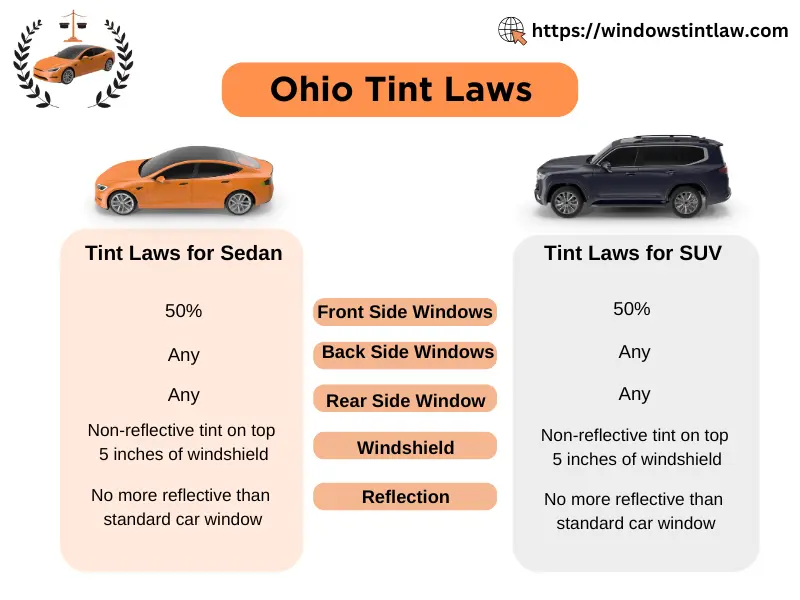Ohio Tint Laws were legislated in 2004, driver must be aware of window tint rules of the state.
Ohio window tinting laws permit vehicle owners to apply the tint or coating materials which should pass 50% of Visible light from the front side windows. However, Non reflection window coating on the top 5 inches of windshield is allowed. Tint percentages refer to the percent of Visible light transmission through the glass windows covered with coating materials.
Keep in mind, the tinting materials must not be reflective or mirrored or shiny in appearance. Hence, drivers are encouraged to install the type of window tinting or glazing materials which should not reflect light to a large extent.
Overview of Ohio Tint Laws
The below infographics reflects the permissible tint limits for Cars and SUVs or Trucks registered in Ohio. According to Ohio Tint Laws 70% of Visible Light must pass through the front windshield of automobile.

Darkest Legal Tint in Ohio
According to window tinting rules in Ohio, Front side windows which are adjacent to driver’s seat must pass 50% of Visible light when coating or tinting material is applied. However, Tinting or glazing materials must not reflect light more than a standard car window without any material installed.
The same rule is applicable for Cars and Trucks operated in Ohio.
| State | Front Side Windows | Back Side Windows | Rear Window | Windshield | Tint Reflection | Other Restrictions |
| Ohio | 50% | Any Tint darkness | Any Tint darkness | Non-reflective tint on top 5 inches of windshield | Metallic or mirrored tint restricted. | No tint colors are prohibited. |
For any further queries, you may consult with Ohio Bureau of Motor Vehicles.
Window Tint Reflection
According to Ohio window tinting rules, Tinted windows of vehicles must have solar reflectance equals to a standard car window without any material installed. Hence, drivers must not install any window glass covering with shiny, metallic or mirrored appearance. Additionally, this rule is applicable for all window types including windshield and pertinent to Cars and Multi-purpose vehicles both.
Other Rules and Regulations
Ohio window tint laws imposed some other rules which are listed below:
- Dual Side Mirrors: There is no restrictions for side mirrors on both sides of vehicle, if the rear window is covered with tinting material.
- Restricted Tint Colors: No Tint color restrictions for side windows, however windshield must not covered with red or yellow tint.
- Certificates: Glass film Manufacturers require to certify the film is legal.
- Stickers: Vehicle owners are required to display the label to identify legal tint on windows between the film and glass.
Medical Exemptions
Ohio state laws do not allow the to install lower tint due to medical conditions. Most of the other states allow tint waiver for individuals suffering with certain medical conditions.
Penalties for Violating Tint Laws
If any person caught with illegal tint in Ohio, shall be guilty of misdemeanor and fined with $120. Law enforcement agencies test the illegal window tint and may ask the driver to remove the illegal glazing material from vehicle windows.
